译林版英语初一上册语法知识
- 格式:doc
- 大小:40.51 KB
- 文档页数:4
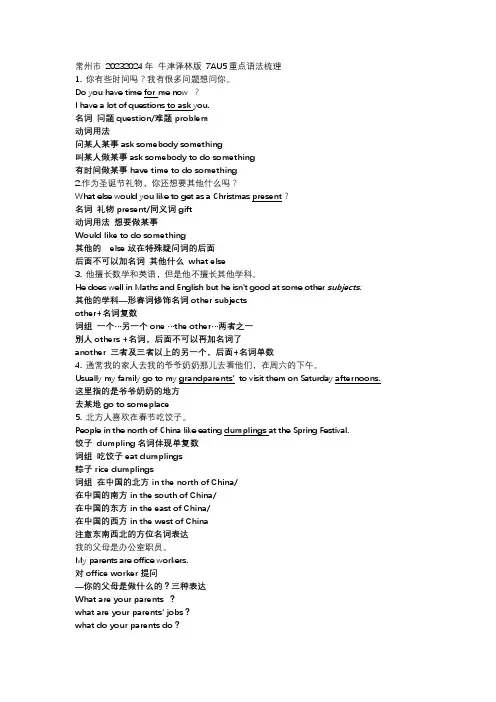
常州市20232024年牛津译林版7AU5重点语法梳理1. 你有些时间吗?我有很多问题想问你。
Do you have time for me now ?I have a lot of questions to ask you.名词问题question/难题problem动词用法问某人某事ask somebody something叫某人做某事ask somebody to do something有时间做某事have time to do something2.作为圣诞节礼物,你还想要其他什么吗?What else would you like to get as a Christmas present?名词礼物present/同义词gift动词用法想要做某事Would like to do something其他的else放在特殊疑问词的后面后面不可以加名词其他什么what else3. 他擅长数学和英语,但是他不擅长其他学科。
He does well in Maths and English but he isn't good at some other subjects.其他的学科—形容词修饰名词other subjectsother+名词复数词组一个…另一个one …the other…两者之一别人others +名词,后面不可以再加名词了another 三者及三者以上的另一个,后面+名词单数4. 通常我的家人去我的爷爷奶奶那儿去看他们,在周六的下午。
Usually my family go to my grandparents’to visit them on Saturday afternoons.这里指的是爷爷奶奶的地方去某地go to someplace5. 北方人喜欢在春节吃饺子。
People in the north of China like eating dumplings at the Spring Festival.饺子dumpling名词体现单复数词组吃饺子eat dumplings粽子rice dumplings词组在中国的北方in the north of China/在中国的南方in the south of China/在中国的东方in the east of China/在中国的西方in the west of China注意东南西北的方位名词表达我的父母是办公室职员。
![译林版][初一上英语Unit2]第二讲Letx27splaysports语法篇(含答案)](https://uimg.taocdn.com/74a8c5330508763230121219.webp)
1第 2 讲 Let ' s play sports!学习目标Brain twister What letter is an ani mal? What letter is a part of head?般现在时 当主语是三单,I 肯定句:主语+动词三单形式+其它1. 学会用英语表达体育运动2. 能够学会在一般现在时态中变化人称单复数3. 能够正确使用一般疑问句4. 学会元音音标发音 What letter is a vegetable? (PEA) (BEE) (EYE)动词变相应的 三单形式。
一 否定句:主语+doesn'+动词原形+其它 一般疑冋句:Does+主语+动词原形+其匕 肯疋句:主语+动词原形+其匕 当主语不是第. 三人称单数时 否定句:主语+don't+动词原形+其它 一般疑冋句:Do+主语+动词原形+其匕We use the simple present tens whe n we talk about:We make positive and n egative senten ces using the verb to do in the simple prese nt tense like this:l/You/We/They likesports..冋曲、沖、 邹:电2精牆练★ do not = don ' t Cah eat Hsh + Millie gets up at 6:30 every morning. Simon likes playing football.thin^ that are true now things that we often do things that arc always truenot = doesn ' tl/You/We/They do notlike sports.He/She/*t does notWe ask and an swer questi ons using the veito do in the simple prese nt tense like this:Do l/you/we/theylike sports?Does he/she/it★ we don' t us do/dose to form questi ons whe n the main verb of the sentence is to be.She is a student. f Is she a student?Remember that we add -s to the verb after he, she or it. However, there are some exceptio ns:Most verbs+ 5like likes play playsVerbs ending tn a conso+ y-y -b ies study studies fly filesVerbs ending tn sh, ss or x+ es watchdresswatchesdresseswashfixwashesfixesdoesl/yot/you/we/they he/she/it do not does not3Some verbs ending in o+ es go goes do does ★ We cha nge have to has whe n it comes after he, she or it.I have a ball. f She has a ball.注释:(1)一般情况下,直接力卩-s,如:bag-bags, cat-cats, pan da-pa ndas, mon key-monkeys, horse-horses(2)以s, x, o, ch, sh, z 结尾的,力卩-es,如:bus-buses, box-boxes, brush-brushes,watch-watches(3)以辅音字母+y结尾的,变y为i+es.如:study-studies.[述LET% EXPLORE ]Millie is writ ing about herself and classmates. Help her complete the sen ten ces withthe correct forms of the verbs in the box.dance go like play watch1. I _________ playing volleyball.2. Kitty _________ very well.453. Amy _________ swimming every week.4. Sim on ofte n ________ football with his friends.5. Daniel sometimes _________ ball games on TVThe students are writing their names under the activities they like in the table below. Complete the questi ons and the n use the in formatio n to an swer them. 1. __ Do ___ Sandy and Kitty enjoy listening to music? _Yes, they do 2. ________ Millie like swimming? ____________ 3. ________ Amy enjoy reading? ____________ 4. ________ Sim on like walki ng? ____________ 5. ________ Sim on and Dani el love drawi ng? ____________ Kitt# Sandy HAVE A TRY Listening to music Swimming Reading Walking Drawing Pt mid rvwi# Wife SandyPulllit Kittif ddnc^Daniel and Sim on are talki ng about their weeke nds. Complete their conv ersati onwith the correct forms of the verbs in brackets.Daniel: Hi. Sitnoir u________________ you____________ (play) football at weekends?Simon: Of course* I often ______________(|>hy> f<K)tball with my cousins.Daniel: " _____________ your parents_____________ (go} with you?Simon: No, they don't. But my dad sometimes 1" (ivatch) ourgiitncs. Sometimes he 内__________________________ (read) at tiomc. My mum oftenm _________ r(shop) at weekends. What abvut you, l^niel?Daniek T often " _ {stay} at home. Sometimes I 他____________________________ 仗o)演练方阵swimming with my dad R一、填空1. We often ___ (play) in the playgo und.2. He ___ (get) up at six o ' clock.3. ___ you _____ (brush) your teeth every morni ng.4. What (do) ____ he usually (do) _____ after school?5. Da nny ___ (study) En glish,Chi nese,Maths,Scie nee and Art an school.6. Mike sometimes ______ (go) to the park with his sister.7. At eight at ni ght,she ________ (watch) TV with his pare nts.8. _____ Mike ________ (read) En glish every day?9. How many lessons _______ y our classmate _______ (have) on Mon day?lO.What time ________ his mother ________ (do) the housework?6二、改句子1. Do you ofte n play football after school?(肯定回答)2.1 have many books.(改为否定句)3. Gao Shan ' s sister likes playing table tennis改为否定句)4.She lives in a small tow n near New York.(改为一般疑问句)5.1 watch TV every day.(改为一般疑问句)6. David has got a goal.(改为一般疑问句)7. We have four less on s.(否定句)8. Nancy doesn ' t run fast肯定句)9. My dog runs fast.(否定句)10. Mike has two letters for him.一般疑问句:否定句:11.1 u sually play football on Friday after noon.否定句:一般疑问句:12.Su Yang usually washes some clothes on Saturday.否定句:7一般疑问句:13. Mingming usually waters the flowers every day否定句:般疑问句:14. Tom does his homework at home.否定句:一般疑问句:三、写出下列动词的第三人称单数形式:1. wash ________ match _______ guess ____ study _____ finish ________go ______ snow _____ carry _________2. stop ______ s ee _______ drive _______ let ______ catch ______ keep _____join ______ f ind ______ think ________ teach ______ d o _____3. stay ______ b egin ______ forget _______ draws _____ lie _______ die _______run ______ prefer _____ give _______ ring _______ d ance _____ hope _______四、翻译1. 他在第三小学上学。
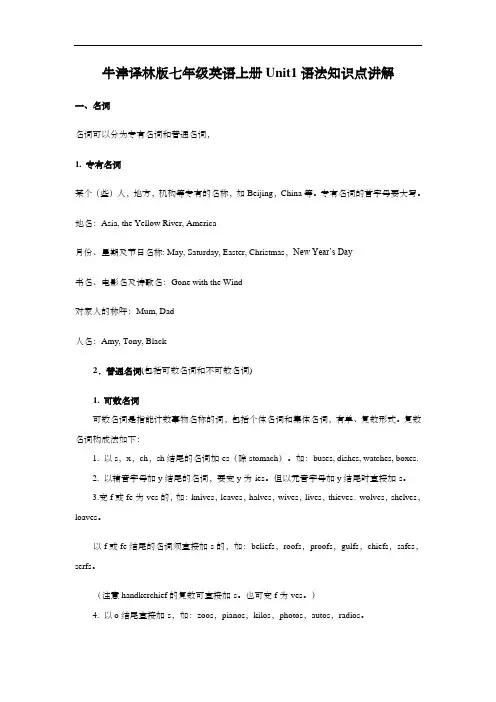
牛津译林版七年级英语上册Unit1语法知识点讲解一、名词名词可以分为专有名词和普通名词,1. 专有名词某个(些)人,地方,机构等专有的名称,如Beijing,China等。
专有名词的首字母要大写。
地名:Asia, the Yellow River, America月份、星期及节日名称: May, Saturday, Easter, Christmas,New Year’s Day书名、电影名及诗歌名:Gone with the Wind对家人的称呼:Mum, Dad人名:Amy, Tony, Black2.普通名词(包括可数名词和不可数名词)1. 可数名词可数名词是指能计数事物名称的词,包括个体名词和集体名词,有单、复数形式。
复数名词构成法如下:1. 以s,x,ch,sh结尾的名词加-es(除stomach)。
如:buses, dishes, watches, boxes.2. 以辅音字母加y结尾的名词,要变y为-ies。
但以元音字母加y结尾时直接加-s。
3.变f或fe为-ves的,如:knives,leaves,halves,wives,lives,thieves.wolves,shelves,loaves。
以f或fe结尾的名词须直接加-s的,如:beliefs,roofs,proofs,gulfs,chiefs,safes,serfs。
(注意handkerchief的复数可直接加-s。
也可变f为-ves。
)4. 以o结尾直接加-s,如:zoos,pianos,kilos,photos,autos,radios。
加-es,如:Negroes,heroes,potatoes,tomatoes。
(有生命的加es, 无生命的加s, 注意植物是有生命的)复数不规则的名词名词复数的不规则变化1)变内部元音。
如foot—feet tooth—teeth man—men woman—women由一个词加man 或woman构成的合成词,其复数形式也是-men 和-women,如an Englishman,two Englishmen。
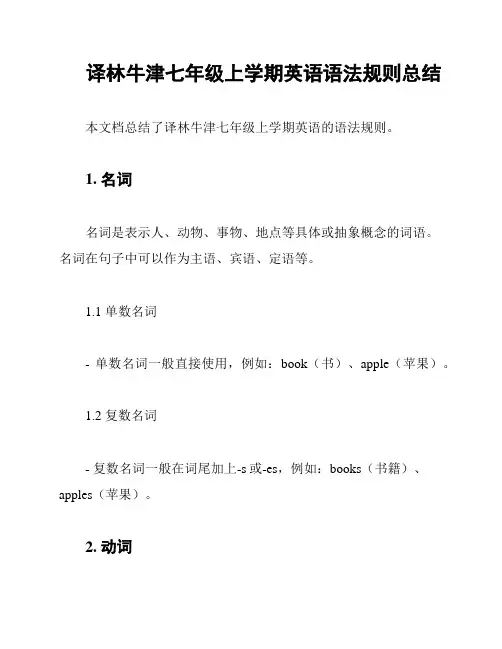
译林牛津七年级上学期英语语法规则总结本文档总结了译林牛津七年级上学期英语的语法规则。
1. 名词名词是表示人、动物、事物、地点等具体或抽象概念的词语。
名词在句子中可以作为主语、宾语、定语等。
1.1 单数名词- 单数名词一般直接使用,例如:book(书)、apple(苹果)。
1.2 复数名词- 复数名词一般在词尾加上-s或-es,例如:books(书籍)、apples(苹果)。
2. 动词动词表示动作或状态的词语。
动词在句子中可以作为谓语、宾语、定语等。
2.1 一般现在时- 一般现在时用于表示经常性或普遍性的行为或状态,例如:I go to school every day(我每天去学校)。
2.2 动词原形- 动词原形用于表示对某事物的普遍性描述,例如:Water boils at 100 degrees Celsius(水在100摄氏度烧开)。
3. 形容词形容词用于修饰名词或代词,表示人或事物的性质或特征。
3.1 形容词的比较级- 形容词的比较级用于比较两个人或事物的差异,例如:She is taller than me(她比我高)。
3.2 形容词的最高级- 形容词的最高级用于比较三个或更多人或事物的差异,例如:He is the tallest boy in the class(他是班级里最高的男孩)。
4. 副词副词用于修饰动词、形容词或其他副词,表示时间、地点、方式、程度等。
4.1 副词的用法- 副词可以修饰动词、形容词或其他副词,例如:She runs quickly(她跑得快)。
5. 介词介词用于表示人或事物在时间、地点、方式等方面的关系。
5.1 常见介词- 常见的介词有in(在)、on(在上面)、at(在...处)等,例如:He is studying in the library(他在图书馆研究)。
6. 冠词冠词用于限定名词。
6.1 定冠词- 定冠词用于表示特定的、已知的人或事物,例如:The book on the table is mine(桌子上的那本书是我的)。
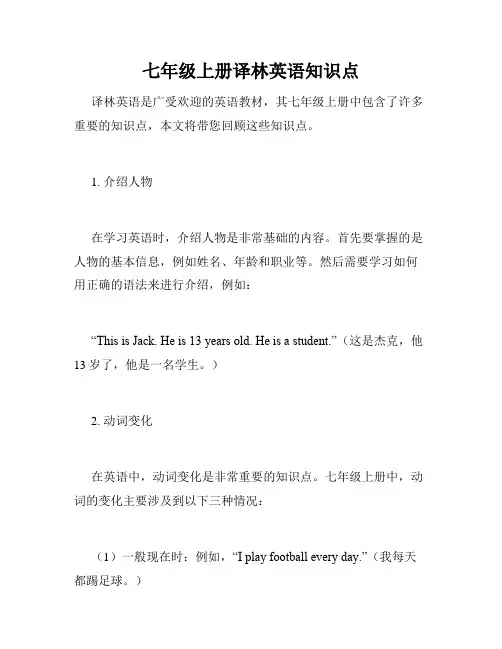
七年级上册译林英语知识点译林英语是广受欢迎的英语教材,其七年级上册中包含了许多重要的知识点,本文将带您回顾这些知识点。
1. 介绍人物在学习英语时,介绍人物是非常基础的内容。
首先要掌握的是人物的基本信息,例如姓名、年龄和职业等。
然后需要学习如何用正确的语法来进行介绍,例如:“This is Jack. He is 13 years old. He is a student.”(这是杰克,他13岁了,他是一名学生。
)2. 动词变化在英语中,动词变化是非常重要的知识点。
七年级上册中,动词的变化主要涉及到以下三种情况:(1)一般现在时:例如,“I play football every day.”(我每天都踢足球。
)(2)一般过去时:例如,“Yesterday, I played football.”(昨天,我踢了足球。
)(3)现在进行时:例如,“I am playing football now.”(我正在踢足球。
)3. 数词数词也是英语中非常重要的一部分。
在七年级上册中,学生需要掌握基本的数字和数词的用法,例如:(1)基数词:例如,“one, two, three”(一、二、三)(2)序数词:例如,“first, second, third”(第一、第二、第三)(3)应用:例如,“There are four seasons in a year.”(一年有四个季节。
)4. 宾语在英语中,宾语是非常基础的知识点。
在许多句子中,宾语被用作动作的接受者。
在七年级上册中,需要掌握以下两种宾语:(1)直接宾语:例如,“I like pizza.”(我喜欢比萨。
)(2)间接宾语:例如,“Tom gave me a book.”(汤姆给了我一本书。
)5. 复数形式在英语中,名词的单复数形式也是非常重要的知识点。
在七年级上册中,需要掌握以下几种名词的复数形式:(1)一般情况:例如,“book-books”(书-书籍)(2)以s, x, ch, sh结尾的名词:例如,“box-boxes”(盒子-盒子们)(3)以o结尾的名词:例如,“potatoes, tomatoes”(土豆-土豆,番茄-番茄)总结以上就是七年级上册译林英语的主要知识点。
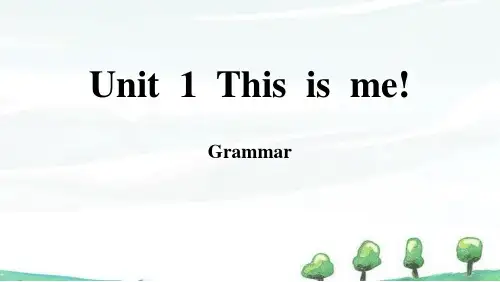
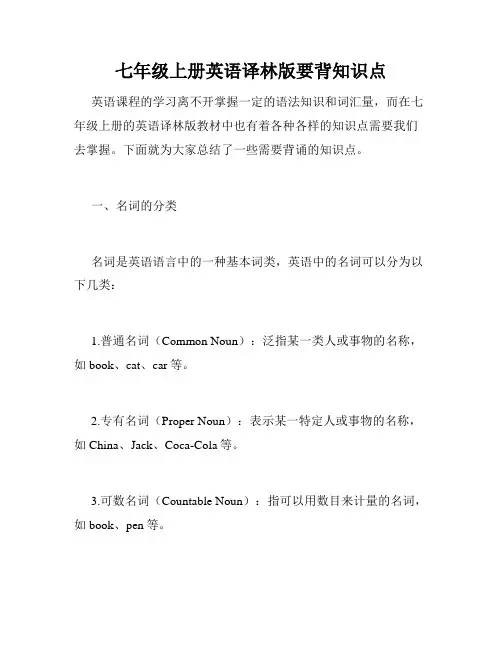
七年级上册英语译林版要背知识点英语课程的学习离不开掌握一定的语法知识和词汇量,而在七年级上册的英语译林版教材中也有着各种各样的知识点需要我们去掌握。
下面就为大家总结了一些需要背诵的知识点。
一、名词的分类名词是英语语言中的一种基本词类,英语中的名词可以分为以下几类:1.普通名词(Common Noun):泛指某一类人或事物的名称,如book、cat、car等。
2.专有名词(Proper Noun):表示某一特定人或事物的名称,如China、Jack、Coca-Cola等。
3.可数名词(Countable Noun):指可以用数目来计量的名词,如book、pen等。
4.不可数名词(Uncountable Noun):指不能用数目来计量的名词,如water、money等。
5.集合名词(Collective Noun):指一组人或物的名称,如class、team等。
6.抽象名词(Abstract Noun):指没有具体形体的名词,如love、happiness等。
二、英语时态英语中包含很多种不同的时态,常见的时态有以下几种:1.一般现在时(Simple Present Tense):表示现在正在发生的动作或状态,如I play basketball every Saturday。
2.一般过去时(Simple Past Tense):表示过去某个时间正在发生的动作或状态,如He went to Beijing last week。
3.现在进行时(Present Continuous Tense):表示正在进行的动作,如They are watching TV now。
4.过去进行时(Past Continuous Tense):表示在过去某个时间正在进行的动作,如I was studying at 8 o'clock last night。
5.一般将来时(Simple Future Tense):表示将来某个时间将要发生的动作或状态,如I will go to school tomorrow。
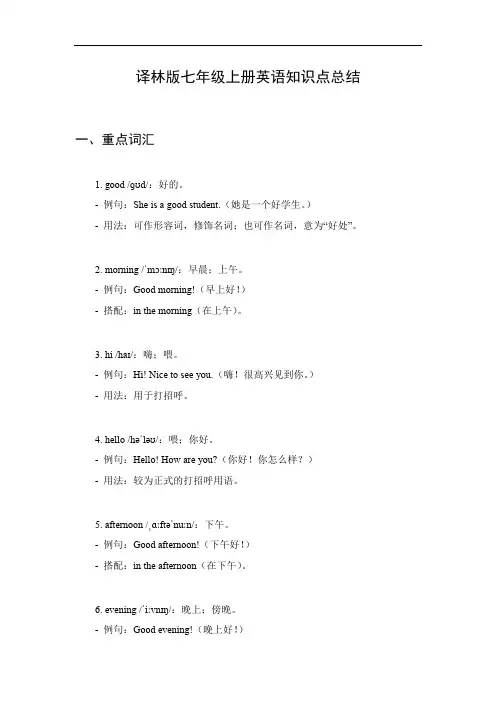
译林版七年级上册英语知识点总结一、重点词汇1. good /ɡʊd/:好的。
-例句:She is a good student.(她是一个好学生。
)-用法:可作形容词,修饰名词;也可作名词,意为“好处”。
2. morning /ˈmɔːnɪŋ/:早晨;上午。
-例句:Good morning!(早上好!)-搭配:in the morning(在上午)。
3. hi /haɪ/:嗨;喂。
-例句:Hi! Nice to see you.(嗨!很高兴见到你。
)-用法:用于打招呼。
4. hello /həˈləʊ/:喂;你好。
-例句:Hello! How are you?(你好!你怎么样?)-用法:较为正式的打招呼用语。
5. afternoon /ˌɑːftəˈnuːn/:下午。
-例句:Good afternoon!(下午好!)-搭配:in the afternoon(在下午)。
6. evening /ˈiːvnɪŋ/:晚上;傍晚。
-例句:Good evening!(晚上好!)-搭配:in the evening(在晚上)。
7. fine /faɪn/:健康的;美好的。
-例句:I'm fine, thank you.(我很好,谢谢。
)-用法:可用于回答“How are you?”。
8. thanks /θæŋks/:谢谢。
-例句:Thanks a lot.(非常感谢。
)-用法:相当于“thank you”,较为口语化。
9. this /ðɪs/:这;这个。
-例句:This is a book.(这是一本书。
)-用法:用于介绍近处的人或物。
10. is /ɪz/:是。
-例句:This is a pen.(这是一支钢笔。
)-用法:用于第三人称单数主语之后。
11. my /maɪ/:我的。
-例句:This is my book.(这是我的书。
)-用法:形容词性物主代词,修饰名词。
12. teacher /ˈtiːtʃə(r)/:老师。
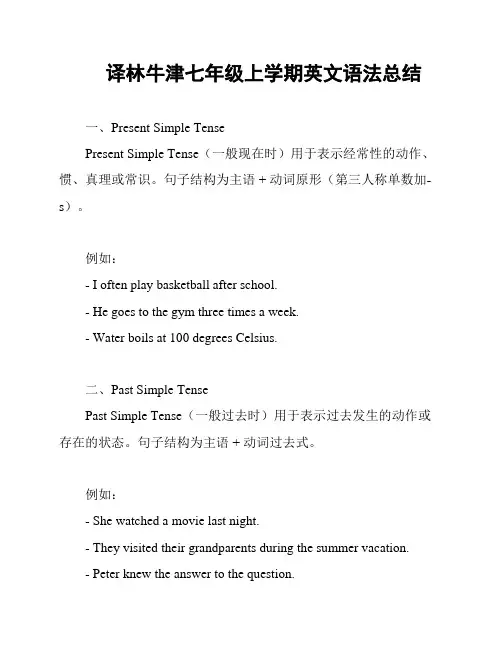
译林牛津七年级上学期英文语法总结一、Present Simple TensePresent Simple Tense(一般现在时)用于表示经常性的动作、惯、真理或常识。
句子结构为主语 + 动词原形(第三人称单数加-s)。
例如:- I often play basketball after school.- He goes to the gym three times a week.- Water boils at 100 degrees Celsius.二、Past Simple TensePast Simple Tense(一般过去时)用于表示过去发生的动作或存在的状态。
句子结构为主语 + 动词过去式。
例如:- She watched a movie last night.- They visited their grandparents during the summer vacation.- Peter knew the answer to the question.三、Present Continuous TensePresent Continuous Tense(现在进行时)用于表示现在正在进行的动作。
句子结构为主语 + am/is/are + 动词-ing。
例如:- I am studying for the English exam right now.- They are playing soccer in the park.- She is reading a book at the moment.例如:- This book is more interesting than that one.- Tom is taller than his brother.- The red car is faster than the blue one.五、SuperlativesSuperlatives(最高级)用于表示多个事物中最高程度的特征。
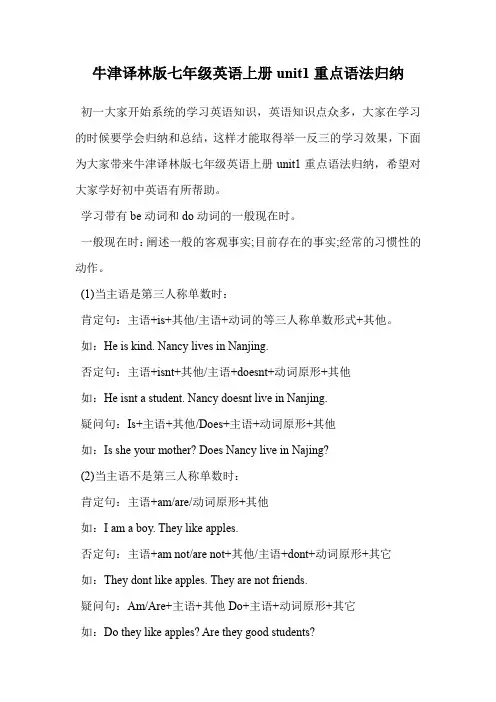
牛津译林版七年级英语上册unit1重点语法归纳初一大家开始系统的学习英语知识,英语知识点众多,大家在学习的时候要学会归纳和总结,这样才能取得举一反三的学习效果,下面为大家带来牛津译林版七年级英语上册unit1重点语法归纳,希望对大家学好初中英语有所帮助。
学习带有be动词和do动词的一般现在时。
一般现在时:阐述一般的客观事实;目前存在的事实;经常的习惯性的动作。
(1)当主语是第三人称单数时:肯定句:主语+is+其他/主语+动词的等三人称单数形式+其他。
如:He is kind. Nancy lives in Nanjing.否定句:主语+isnt+其他/主语+doesnt+动词原形+其他如:He isnt a student. Nancy doesnt live in Nanjing.疑问句:Is+主语+其他/Does+主语+动词原形+其他如:Is she your mother? Does Nancy live in Najing?(2)当主语不是第三人称单数时:肯定句:主语+am/are/动词原形+其他如:I am a boy. They like apples.否定句:主语+am not/are not+其他/主语+dont+动词原形+其它如:They dont like apples. They are not friends.疑问句:Am/Are+主语+其他Do+主语+动词原形+其它如:Do they like apples? Are they good students?牛津译林版七年级英语上册unit1重点语法归纳为大家带来过了,英语的学习重在掌握知识点,希望大家能够熟练掌握上面的内容,这样大家的英语成绩就能迅速提升。
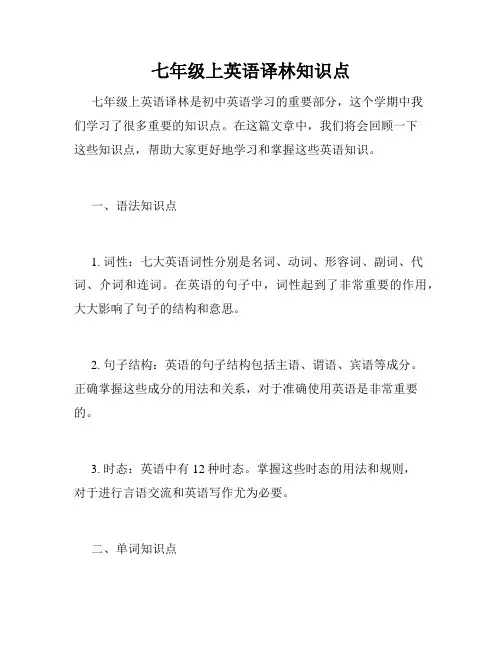
七年级上英语译林知识点七年级上英语译林是初中英语学习的重要部分,这个学期中我们学习了很多重要的知识点。
在这篇文章中,我们将会回顾一下这些知识点,帮助大家更好地学习和掌握这些英语知识。
一、语法知识点1. 词性:七大英语词性分别是名词、动词、形容词、副词、代词、介词和连词。
在英语的句子中,词性起到了非常重要的作用,大大影响了句子的结构和意思。
2. 句子结构:英语的句子结构包括主语、谓语、宾语等成分。
正确掌握这些成分的用法和关系,对于准确使用英语是非常重要的。
3. 时态:英语中有12种时态。
掌握这些时态的用法和规则,对于进行言语交流和英语写作尤为必要。
二、单词知识点1. 常用单词:简单的常用单词就有很多,包括色彩、数字、天气和身体部位等。
掌握这些单词对于英语初学者来说非常重要。
2. 固定短语:固定短语是由两个或多个单词组成的固定搭配。
正确掌握这些固定短语的用法和意思,可以帮助我们更好地进行英语表达。
3. 同义词和反义词:同义词和反义词在英语中非常常见。
掌握这些词汇,可以扩大英语词汇量,增加学习写作和口语表达的灵活性。
三、语音知识点1. 音标:音标是一个非常重要的语音知识点。
在学习英语过程中,我们需要学会正确发音,并掌握各个音素的发音规则。
2. 重读规则:英语单词中有很多重读音节和非重读音节。
了解这些重读规则可以帮助我们更好的记忆单词,也帮助我们更好地理解英语文本。
四、阅读技巧1. 阅读理解:阅读理解是英语学习的重要组成部分。
通过不断的阅读和练习,我们可以提高自己的阅读理解能力。
2. 速读技巧:速读技巧可以帮助我们更高效的阅读英语文本。
掌握一些句子结构、重点词汇等技巧,让我们能够更好地理解英文文章。
五、写作技巧1. 写作格式:掌握英语写作的格式规范对英语学习来说非常重要。
在写作方面越规范,越容易理解和被人理解。
2. 写作原则:学习写作原则可以帮助我们更好地提高写作能力。
例如,内容要点要鲜明明了、逻辑性强等等。
七年级英语上译林版知识点讲义英语是一门重要的语言,也是国际通用语言之一。
学习英语对于我们而言具有重要的意义和价值。
作为初学者,我们需要掌握一些基本的知识点,以便更好地学习和运用英语,那么下面我将为大家介绍七年级英语上译林版的知识点讲义。
一、基础语法1. 一般现在时:表示经常、习惯性、满足条件或真实情况下所发生的动作或状态,并且该时态中动词原形不加变化。
例如:He always goes to school by bike.2. be动词的使用:表示状态或特定时间内发生的行为,并且be 动词根据主语的单复数、时态、语气等不同而进行变化。
例如:I am a student.3. 祈使句:表达请求、命令、建议等,一般使用动词原形。
例如:Please turn off the lights.4. 一般过去时:表示过去某个时间内所发生的事情,并且该时态中动词要进行过去式变化。
例如:Yesterday, I went to the park.5. 一般将来时:表示将来某个时间内所要发生的事情,并且该时态中动词需要加上will或be going to。
例如:I will visit my grandparents next week.6. 现在进行时:表示现在正在进行的动作,并且该时态中动词需要加上动词-ing形式。
例如:I am watching TV now.二、词汇1. 名词:表示人、事、物等,常用的有可数名词和不可数名词。
例如:book、cat、water等。
2. 代词:代替名词或名词短语,常用的有人称代词、物主代词、指示代词等。
例如:he、her、it等。
3. 动词:表示动作或状态的词语,常用的有不规则动词和规则动词。
例如:go、eat、play等。
4. 形容词:用来描述名词的性质或特征,常用的有比较级和最高级。
例如:beautiful、tall、big等。
5. 副词:用来描绘动词、形容词、其他副词的程度、方式、时间或地点。
牛津译林版七年级英语上册Unit7语法知识点汇总PartI 、some 与anysome意为“一些”、“几个”,通常用于肯定句中。
现将其主要用法归纳如下:一、some作形容词用时,可以修饰复数可数名词,也可以修饰不可数名词。
例如: There are _________ students in the classroom. 教室里有几个学生。
There ______ some milk in the glass. 杯子里有一些牛奶。
二、some作代词用时,可在句中作主语或宾语。
例如: Some of the boys _______ playing games now. 有几个男孩现在正在做游戏。
I have no paper. Please give me __________. 我没有纸了,请给我一些吧。
三、some有时也可以用在疑问句中,表示请求、建议,并期望得到对方的肯定回答。
它也可以用于反问句中。
例如: Can you give me________ money? 你能给我一些钱吗? Would you like________ more rice? 再来点米饭好吗? Why don’t you buy __________ flowers for her? 你为什么不给她买些花呢?any也有“一些”的意思,但它常用在否定句、否定答语或疑问句中。
其具体用法如下:一、any作形容词用时,可以修饰可数名词的单数或复数,也可以修饰不可数名词。
例如: Do you have________ questions to ask? 你有什么问题要问吗? There isn’t ________ water in this bottle. 这个瓶子里没有水。
二、any作代词用时,也可用于肯定句中,表示“任何”的意思,起强调作用。
例如: You may take _______ of them. 这些东西,你随便拿哪个都行。
七年级英语语法知识点译林七年级英语语法知识点随着七年级的来临,我们开始学习英语语法知识。
掌握英语语法是非常重要的,它是英语学习中的基石。
在这篇文章中,我们将为您介绍几个七年级英语语法知识点,帮助您掌握这门语言。
1. 动词时态动词时态指的是时间和一般现在时、一般过去时和一般将来时之间的关系。
我们使用一般现在时表示一些现在正在发生或经常发生的事情。
例如,“我每天早上六点起床”。
一般过去时用于表示已经完成的动作或事件。
例如,“我昨天看了一部电影”。
一般将来时用来表示将要发生的事件或行动。
例如,“我将在下周去旅行”。
2. 名词名词是指人、动物、事物、想法或概念等的名称。
在英语中,名词可以分为可数名词和不可数名词。
可数名词可以用数词进行计数,例如,“一个苹果”或“两个机会”。
相反,不可数名词没有明确的数量,例如,“水”或“时间”。
3. 形容词和副词形容词和副词用于描述事物或情况。
形容词通常用于描述名词或代词。
例如,“这是一只漂亮的猫”。
副词通常用于修饰动词或其他副词。
例如,“他快速地跑过了街道”。
4. 代词代词是用于代替名词的词语。
例如,“他”、“她”和“它”都是代词。
代词分为主格和宾格。
主格代词通常用于作为主语,而宾格代词通常用于作为宾语。
例如,“他给了我一个礼物”。
5. 介词介词是用于连接名词、代词或动词与其他句子部分的词语。
例如,“在”、“在…之后”和“在…之前”都是介词。
它们描述了如何将一个词与句子的其他部分联系起来。
例如,“我在学校读书”。
总结以上仅是英语语法的一小部分,但是对于初学者来说是基本的知识点。
掌握这些语法知识是为了更好地理解和使用英语。
希望这篇文章对您有所帮助,祝您学习愉快!。
七上 U8 复习重点总结(必定要牢哦!)1.疑 + to do :穿什么 /做什么 /去哪儿 /如What to wear/ What to do /Where to go / how to do it .何做They are talking about what present to buy for Simon.件事2.在床上多呆十分spend ten more minutes in bed=stay in bed for another ten minutes.再来一些 / 再来几个蛋糕/ 再来一些牛肉some more books / a few more cakes / a little more beef3.你的女士衫尺是多少 4号。
What size is your blouse Size4.4.今日我将向你展现不同式的服饰.Today we are going to show you different styles of clothes.5.我正衣着运装和一双运鞋 .I am wearing sports clothes and a pair of trainers.6. Simon 来了!Here comes Simon. = Simon is coming.7.他两个都衣着色牛仔 .Both of them are (They are both/ Both A and B are) wearing jeans.年人真的喜牛仔 .Young people really like jeans.8.今日的演出到此止。
That ’ s all for today’s show.9.由⋯制成This bottleis made of glass.(看得出原料)Paper is made from wood. (看不出原料) ( 接地 )10. 大多半年人喜牛仔。
Most young people like jeans. = Most of the young people like jeans.=Jeans are popular among most young people.11. 他和他的朋友正在操上踢足球。
七上U8复习要点总结(一定要牢记哦!)1.疑问词+ to do:穿什么/ 做什么/ 去哪儿/ 如何做这件事// 他们正在讨论给Simon买什么礼物.What to wear/ What to do /Where to go / how to do it. They are talking about what present to buy for Simon.2.在床上多呆十分钟再来一些书/ 再来几个蛋糕/ 再来一些牛肉spend ten more minutes in bed=stay in bed for another ten minutes. some more books / a few more cakes / a little more beef3.你的女士衬衫尺码是多少?4号。
What size is your blouse? Size4.4.今天我们将向你们展示不同样式的服装.Today we are going to show you different styles of clothes.5.我正穿着运动装和一双运动鞋.I am wearing sports clothes and a pair of trainers.6. Simon过来了!Here comes Simon. = Simon is coming.7.他们两个都穿着蓝色牛仔裤.年轻人真的喜欢牛仔裤.Both of them are (They are both / Both A and B are) wearing jeans. Young people really like jeans.8.今天的演出到此为止。
That’s all for today’s show.9. 由…制成This bottle is made of glass. (看得出原料)Paper is made from wood. (看不出原料)/// It is made in China. (接产地) 10.大部分年轻人喜欢牛仔裤。
七年级上册英语语法
1.动词be(is,am,are)的用法
我(I)用am, 你(you)用are,is跟着他(he),她(she),它(it)。单数名词用is,复
数名词全用are。变否定,更容易,be后not加上去。变疑问,往前提,句末问号莫丢弃。
还有一条须注意,句首大写莫忘记。
2.this,that和it用法
(1)this和that是指示代词,it是人称代词。
(2)距离说话人近的人或物用this, 距离说话人远的人或物用that。如:
This is a flower. 这是一朵花。(近处)
That is a tree. 那是一棵树。(远处)
(3)放在一起的两样东西,先说this, 后说that。如:
This is a pen. That is a pencil. 这是一支钢笔。那是一支铅笔。
(4)向别人介绍某人时说This is…, 不说That is…。如:
This is Helen. Helen, this is Tom. 这是海伦,海伦,这是汤姆。
(5)This is 不能缩写, 而That is可以缩写。如:
This is a bike. That’s a car. 这是一辆自行车。那是一辆轿车。
(6)打电话时,介绍自己用this, 询问对方用that。如:
—Hello! Is that Miss Green? 喂,是格林小姐吗?
—Yes, this is. Who’s that? 是的,我是,你是谁?
注意:虽然汉语中使用“我”和“你”,但英语中打电话时绝不可以说:I am…, Are you…?
/Who are you?
(7)在回答this或that作主语的疑问句时, 要用it代替this或that。如:
①—Is this a notebook? 这是笔记本吗?
—Yes, it is. 是的,它是。
②—What’s that? 那是什么?
—It’s a kite. 是只风筝。
3.these和those用法
this, that, these和those是指示代词,these是this的复数形式,指时间,距离较近
的或下面要提到的人或事;those是that的复数形式,指时间、距离较远或前面已经提到过的
人或事物。
①This is my bed. That is Lily’s bed. 这是我的床。那是莉莉的床。
②These pictures are good. 那些画很好。
③ Are those apple trees? 那些是苹果树吗?
在回答主语是these或those的疑问句时,通常用they代替these或those以避免
重复。如:
④Are these/those your apples? 这些(那些)是你的苹果吗?
Yes, they are. 是的,他们是。
4.名词+’s所有格
单数名词后直接加 “ ’s ”:
Jim’s coat 吉姆的外套 Jeff’s mother杰夫的妈妈
以s结尾的复数名词,只加“’”
Teachers’ Day教师节 the twins’ books双胞胎的书
不以s结尾的不规则的名词复数,加“ ’s ”
Children’s Day 儿童节 men’s shoes男式鞋
表示两者共同拥有时,只在最后一个名词后加’s
Lucy and Lily’s mother 露茜和莉莉的妈妈(共同的妈妈,一个妈妈)
表示两者各自拥有时,要在每个名词后加’s
Lucy’s and Kate’s rooms 露茜和凯特的房间(各自的房间,两间房子)
5.There be句型
(1)There be句型主要用以表达“某处(某时)有某人(某物)。”其基本结构为“There
be+某物(某人)+某地(某时)”其中there是引导词,没有词义;主语是be后面的名
词, be是谓语动词,在一般现在时中be只用is和are两种形式。下面这首歌诀可帮你
巧记there be句型结构:
There be放句首,主语跟在后。地、时放句末,强调置前头。如:
There is a book on the desk.
有时为了强调地点,也可把介词短语放在句首。如:
On the desk there is a book.
(2)There be句型中的be动词如何确定呢?请先看看下面这首歌诀:
Be动词,有三个,am,is还有are。“There be”真特别,不留am只留俩,那就是is
还有are。要用is还是are,须看其后的名词是单数还是复数。若是单数或不可数名词用is,
否则就用are。如:
①There is a tree behind the house.
②There is some water(水)in the bottle(瓶子).
③There are some pears in the box.
(3)注意:如果“be”后的主语是由and连接的两个或两个以上的名词,那么be的形式
要遵循“远亲不如近邻”的原则。也就是说,“be”的形式是由与它最近的那个名词来确定的。
若那个名词是单数或不可数名词要用is,是复数就用are。如:
①There is a book and some pens on the floor.
②There are some pens and a book on the floor.
6.like一词的用法
like用作及物动词,译为“喜欢”。
(1)后接名词或代词,表示喜欢某人或某物。如:
I like the baby very much. 我非常喜欢这个小孩。
(2)后接动名词(v. -ing),表示“喜欢做某事”,着重于习惯、爱好。如:
Tom likes playing football. 汤姆喜欢踢足球。
(3)后接动词不定式(to do ),表示“偶尔地喜欢做某事”,着重于某次具体的行为。如:
I like reading, but I like to watch TV this evening. 我喜欢读书,但我今晚想看电
视。
7.句子单数变复数,注意以下五要素
(1)主格人称代词要变成相应的复数主格人称代词,即I→we, you→you,she,he,it→ they。
如:She is a girl. →They are girls.
(2)am,is要变为are。如:
I’m a student. →We are students.
(3)不定冠词a,an要去掉。如:
He is a boy. →They are boys.
(4)普通单数名词要变为复数形式。如:
It is an apple. →They are apples.
(5)指示代词this,that要变为these,those。如:
This is a box. →These are boxes.
8.英语日期的表示法
英语中月份和星期名称都是专有名词,它们的首字母必须大写,并且前面无需用冠词。
用英语表示日期,其顺序为月+日+年,日和年之间需用逗号隔开。如:August 2nd,
2003(2003年8月2日)。也可以用日+月+年来表示。如:10th May,2003(2003年5月
10日)英语日期前介词的使用:若指在哪一年或哪一月,则用介词in,若具体到某一天,则
需用介词on。
9.时间的表达法
(1) 直读式,即直接读出时间数字
7: 05 seven five 8:16 eight sixteen
(2) 过、差式,即几点差几分,几点过几分。(以30分为分界线)
1:25 twenty-five past one 2:30 half past two
3:43 seventeen to four 4:38 twenty-two to five
(3)12小时制
6:00 a.m. 上午6点 8:20 p.m. 下午8点20分
(4)24小时制
13:00 13点钟 22:15 22点15分
(5)15分可用quarter
4:15 a quarter past four 5:45 a quarter to six
(6)时间前通常用at.
at 5 o’clock at 7:30 p.m.
10. want用法
(1)想干什么用want to do sth
They want to join the sports club. 他们想加入运动俱乐部。
(2)第三人称单数作主语,want要作变化
①He wants to play basketball.
②Li Xia wants to play the piano.
(3)变疑问句,否定句要借助助动词do或does.
①-Do you want to play soccer ball ? -Yes , I do . / No , I don’t.
②-Does he want to go home by bus ? -Yes , he does . / No , he doesn’t